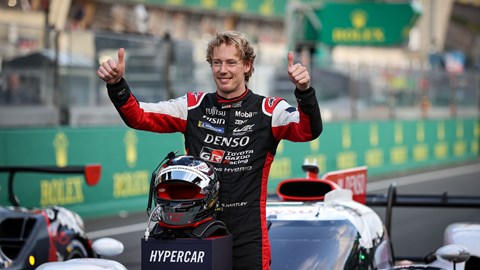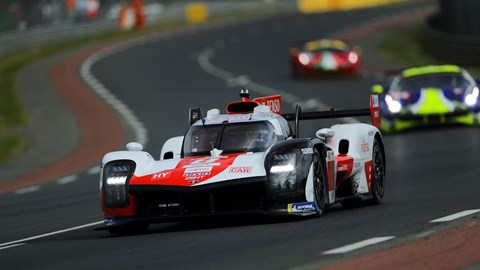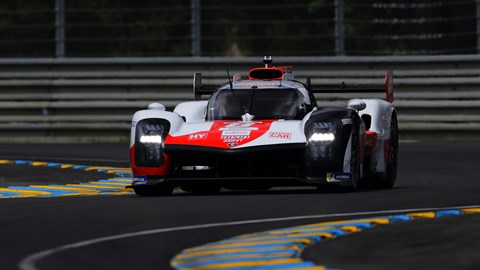► Brendon Hartley on pole for 2022 race
► Five areas you can find massive time
► But there are risks
Although Le Mans is an endurance race at heart, pure pace is an increasingly important factor – especially with reliability improving throughout the field. Around Le Mans, a handful of tenths can extrapolate to laps over 24 hours, and qualifying is also massively important for track position – especially if you’re in equal cars.
‘It’s the fastest the car is all weekend,’ says Brendon Hartley, after putting the #8 Toyota GR010 on pole – narrowly beating the sister car’s Kamui Kobayashi. ‘Low fuel, new tyres, the track’s ramping up, there’s not [many] cars on track, so there’s a good chance of getting the traffic-free lap. And the feeling of doing that around here is something quite special.’

So – setup aside – just where is pole at Le Mans won and lost, and where do you really need to attack to nail a hot lap? Here’s how to stick it on pole, according to 2022 polesitter Brendon Hartley.
1. Turn one
Le Mans is full of challenges, and they begin immediately after crossing the start/finish straight: turn one is key for holding track position at the start – as well as avoiding contact – but it’s also the first chance to gain or lose some serious time.

‘I think the first quarter on the track – braking zone one is very tricky because you’re turning,’ says Hartley. ‘Basically, you’re hitting the brake but you’re still turning, so it’s a very easy opportunity to make a small mistake.’
2. Tertre Rouge
The Le Mans circuit is dominated by the Mulsanne straight, and despite the addition of two chicanes it’s still a hugely important part of the track. Nailing the entry is massively important, because any time lost or gained is multiplied along its length. And like most things in motorsports, it’s all about flirting with the rules.
‘If you go just beyond the white line, you get the lap time removed,’ Hartley explains. ‘It’s a lot quicker if you do that. You want to you want to dance with that line. You want to get as close as you can.’
‘And you know that the lap time gain is going to be big for the entire straight. So, if you can carry a bit more speed through there, you win a lot, but the risk – not in terms of crashing, but losing the lap time – is very high. That’s actually somewhere where Kamui [Kobayashi] took a lot of laptime from me.’

3+4. The chicanes (1st and 2nd Ralentisseur)
The potential for gaining an advantage is often larger in slow speed corners, and Le Mans is no different. Two of the best places to find time against another driver are the chicanes on the Mulsanne straight. Get them right, brake at the very last centimetre, and you’ll have a much higher average speed than the competition.
‘I love those chicanes. I’ve always felt comfortable with them, but what I want to say there is you have a lot of time to think about where you’re going to brake,’ Hartley reveals. ‘So we’re hitting the brake pedal around just after the 100 metres from the corner and we’re going through there at around 330kph (205mph) so you have a long time to think about it.’
‘Are you going to do 100 metres, 95, maybe 90 metres? You know, normally on a qualifying lap, you don’t have the time to really think about it. But yeah, you have to kind of come to mind and say no, don’t overthink this.’
5. The Porsche curves
The Porsche curves are one of the best places to watch the physics-bending grip of Le Mans prototypes. Fast and flowing, they require maximum commitment, a precise line and a serious dollop of downforce.
‘The Porsche curves are a part of the circuit that everyone loves,’ Hartley tells us. ‘Incredibly high speed, that’s where these cars feel alive, [where] they have the most grip. You have all this downforce from the car.’

‘And given you know you’re taking the maximum speed through there, there is a risk of having an accident or track limits on the exit for cutting – and the wall’s close there. But it’s an amazing feeling to be going through there at the speeds we are.’
And what about the race?
Le Mans used to be about reliability as much as overall speed, but in 2022 attrition is less of a factor. That means drivers need to push constantly to stay ahead, or at the very least, to build a healthy buffer should their car have an issue.
‘It’s a very fine margin,’ Hartley says, when asked how different racing is compares to qualifying. ‘Actually, they’re pretty closer than you’d expect. Right now we’re right up against the limit for 24 hours,’ Hartley says.
‘Where you must pay more attention is when the tyres are cold. These are the moments; when the tyres are very old on the third stint, where you may be taking slightly more margin, but generally speaking, we are ten tenths. We’re pushing to the maximum.’